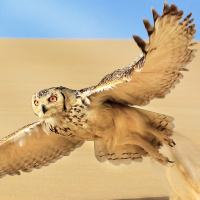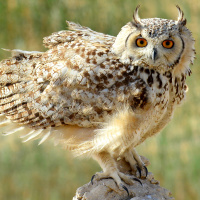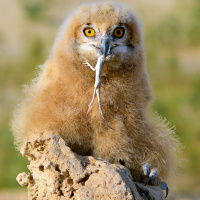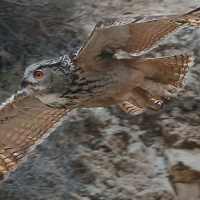Introduction
The Pharaoh Eagle Owl is a fairly large owl with relatively short and pointed ear-tufts. It is also known as the Desert Eagle Owl, Savigny's Eagle Owl or the Sahara Eagle Owl.
Photo Gallery (6 pictures)
Information
Description: The facial disc is plain pale tawny, with a rim made up of fine blackish spots. The eyes are yellow to deep orange. The cere
is greyish and the bill is black. The ear-tufts are relatively short and pointed, and pale tawny with dark speckles and tawny-brown edges. The crown is pale
tawny with many blackish-brown spots.
Upperparts are tawny-rufous, marked dark and light (the shoulders being slightly darker than the back), with individual feathers having dark shaft-streaks with
whitish spots on each side, and a broad blackish tip, giving a blotched effect. Scapulars are the same as the back and mantle. Flight and tail feathers are
barred light and dark.
The throat is white, and the rest of the underparts are pale tawny-brown to sandy-coloured. The upper breast has dark drop-shaped shaft-streaks and a few
cross-bars. The lower underparts are finely marked dark, with individual feathers having a thin shaft-streak and a thin horizontal bar.
Tarsi and toes are feathered pale tawny, the feathering more sparse towards the base of the claws. The tips of the toes are sooty-brown, and the claws are
blackish-brown with darker tips.
Size: Length 45-50cm. Wing length 324-430mm. Tail length 160-233mm. Weight about 1900-2300g. Females are larger and heavier than males.
Habits: The Pharaoh Eagle Owl becomes active after sunset. Roosts by day between rocks, either on the ground or in a steep precipice, cliff crevice or in a cave entrance. They may also roost in a tree if present.
Voice: The song of the male is a short, downward-inflected "Buo". The female has a similar but higher-pitched song. During courtship, a trisyllabic call is uttered with emphasis on the first note, then a slightly higher pitched second and third - "hu-huhoooh". Sometimes only part of this phrase is sung. Such phrases are repeated at intervals of about eight seconds. Dueting occurs during courtship.
Hunting & Food: The Pharaoh Eagle Owl feeds mainly on small vertebrates such as mammals, birds and reptiles, but also larger insects and scorpions. While rodents make up the main diet, hares, bats, desert foxes and hedgehogs are also taken. This owl normally hunts from a perch.
Breeding: Male and female generally pair for life, maintaining the same territory for years. The nest is a shallow scrape among rocks, in a crevice or down a well. On new desert fringes of the sub-Sahara, tree holes or old nest of larger birds are used. A clutch of 2-4 (usually 2) white eggs (55-62 x 45-50mm) is laid directly on the base of the nest site. There is a 2-4 day interval between the laying each egg, and the female incubates them alone, starting with the first egg, while the male supplies the food. Incubation lasts 31-36 days. Chicks are brooded and fed by the female alone for about two weeks, after which the male shares the feeding duties. The young leave the nest at 20-35 days and are fully fledged at about 52 days. They are guided and fed by both parents for 20-26 weeks. They reach maturity in the year following hatching, but do not normally breed before two years of age.
Habitat: Rocky deserts and semi-deserts, mountains with gorges and cliffs, dry, rocky mountain slopes with scattered trees or shrubs, outcrops of oases, occasionally in dry savannas.
Distribution: Northwestern Africa with patchy distribution across northern Africa and the Middle East to Oman.
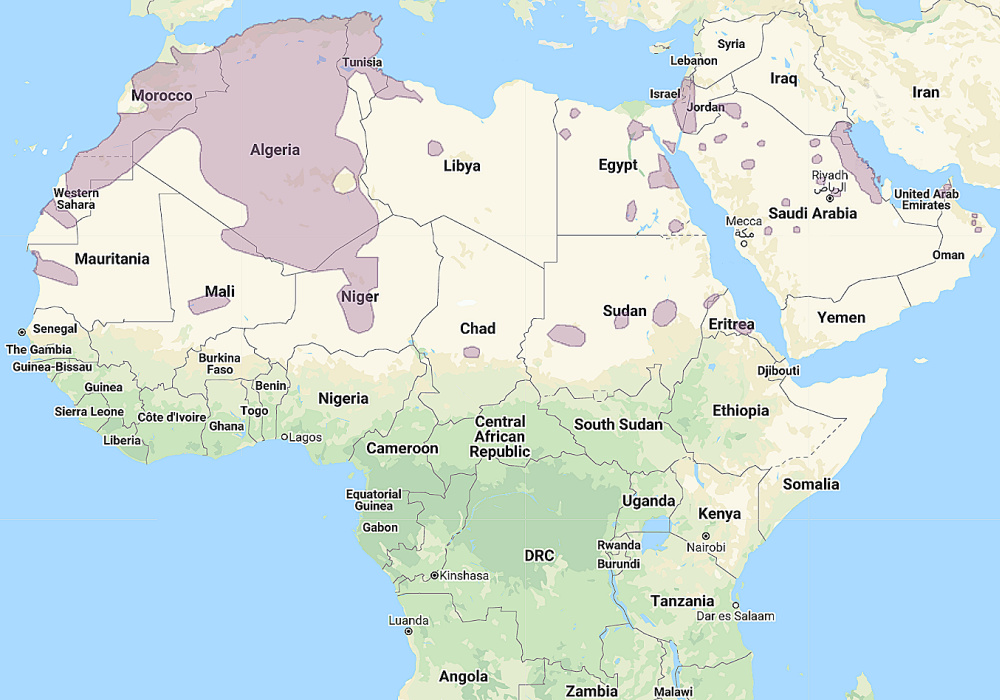
Range of the Pharaoh Eagle Owl Bubo ascalaphus
Status: Listed as 'Least Concern' by Birdlife International.
Original Description: Savigny, Narie-Jules-Cesar LeLorgaede. 1809. Description d'Egypte; ou Recueil des observations et des recherches qui ont ete faites en Egypte pendant l'expedition de l'armee francaise (Descr. Egypte. [1798-1801]) livr. 23 p. 295.


